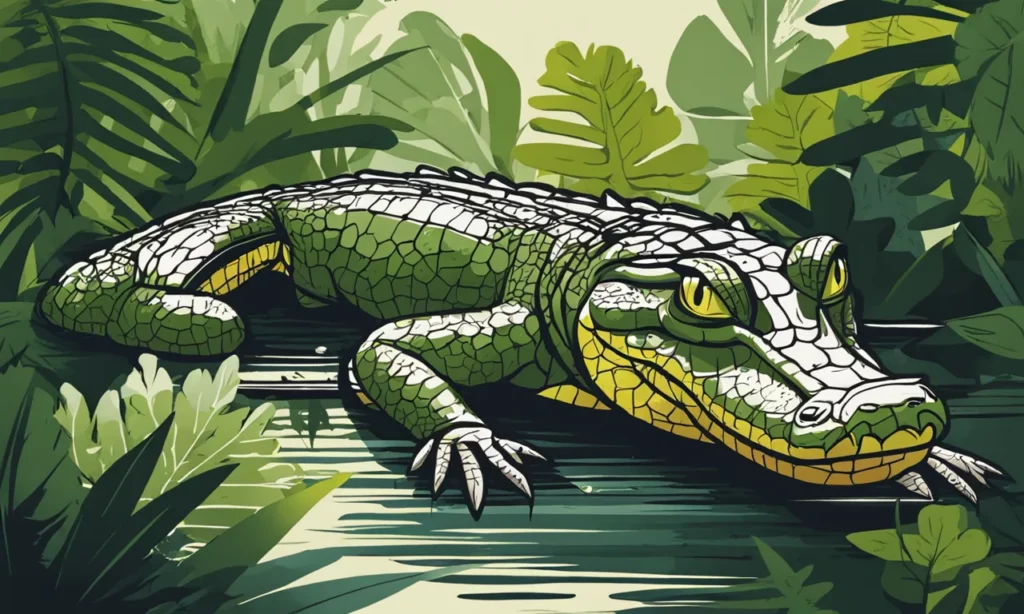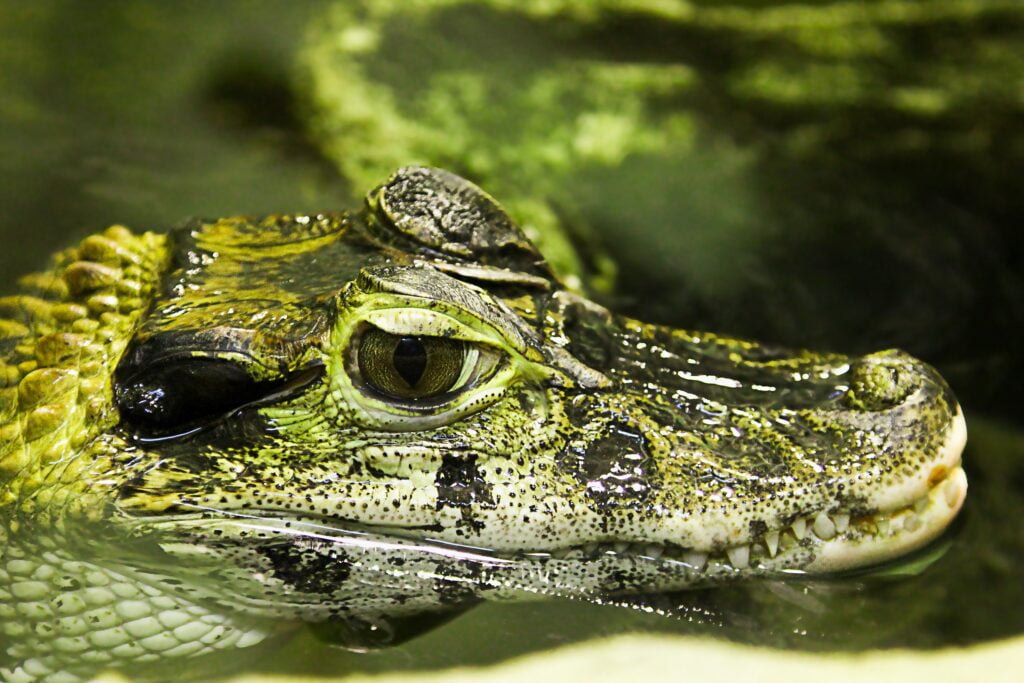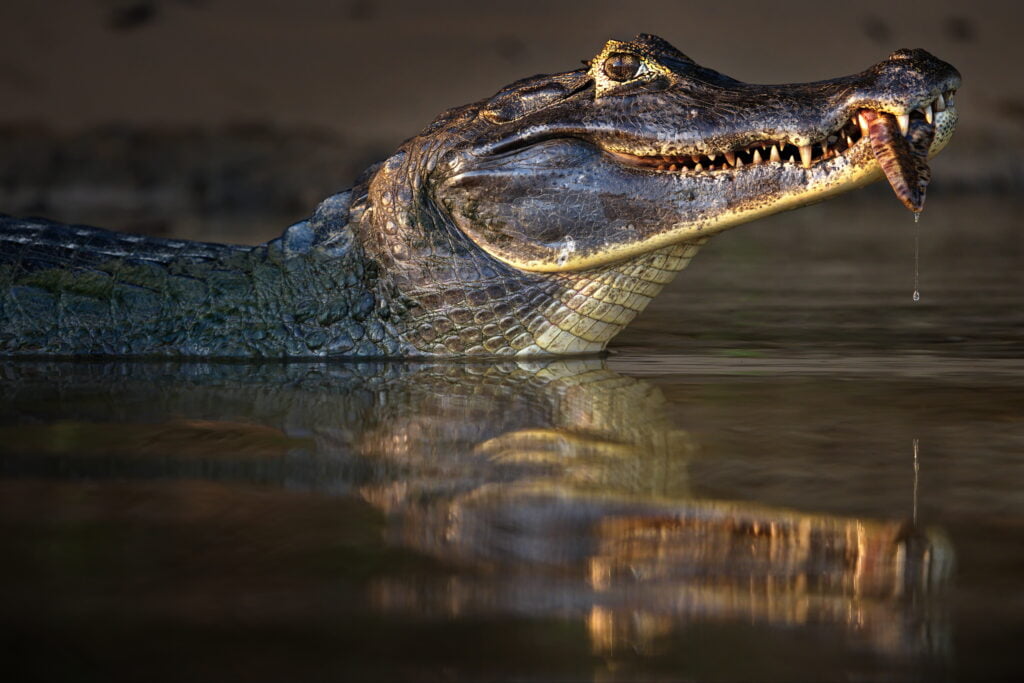15 Interesting Facts About Caiman

Caimans are captivating reptiles found in the wetlands of Central and South America. In this article, we’ll explore 15 fascinating facts about these creatures, covering various aspects such as:
Get ready to dive into the world of caimans and discover what makes them so intriguing.

1. Habitat
Caimans inhabit freshwater marshes, swamps, rivers, and lakes throughout Mexico, Central America, and South America. Some species, like the spectacled caiman, can even tolerate brackish or salty waters, allowing them to occupy coastal mangrove habitats. Their range extends from Mexico down to Argentina.
2. Classification
Caimans belong to the family Alligatoridae, along with their close relatives, alligators. There are six existing species of caiman, including the spectacled caiman, yacare caiman, broad-snouted caiman, black caiman, Cuvier’s dwarf caiman, and smooth-fronted caiman. Several extinct species are also known from the fossil record.
3. Size

Most caiman species measure 6 to 8 feet long when fully grown. However, the black caiman is significantly larger. It can reach over 16 feet in length and weigh up to 2,200 pounds! At the other extreme, Cuvier’s dwarf caiman reaches just 4 to 5 feet as an adult.
4. Appearance
Caimans have long, streamlined bodies with thick armored skin covered in non-overlapping scales. Their coloration is quite variable between species, ranging from olive, brown or gray to black. They have pronounced snouts, powerful tails, and webbed feet. Their eyes and nostrils sit high on their skull so they can see and breathe while most of their body is submerged.
5. Senses
A caiman’s senses are finely tuned for hunting in aquatic environments. They have excellent vision, including good color vision and night vision. Their hearing is also acute, despite having small ear openings. But their strongest sense is smell – caimans can detect prey in the water from great distances by picking up chemical cues in the water.
6. Hunting
Caimans are ambush predators that wait patiently, nearly motionless, for prey to come within striking distance. They then explode into action with remarkable speed and power. On land, caimans may actively pursue prey over shorter distances. They grab prey with their massive jaws and drag it into the water to drown. Caimans swallow their food whole, so prey size is limited by their gape.
7. Diet

Fish make up the bulk of their diet, but caimans also prey on a wide variety of other animals. Larger species can tackle big game like capybara, deer, peccaries, and turtles. They sometimes grab domestic livestock or pets, which brings them into conflict with local human populations. Carrion is also readily consumed.
8. Jaws and Teeth
A caiman’s jaws contain around 80 sharp conical teeth designed for grabbing and holding struggling prey. They have immensely powerful bite forces, estimated to be over 3,000 psi in large species like the black caiman. If a tooth is broken or worn down, it will be continuously replaced throughout the caiman’s life.
9. Reproduction
During the dry season mating occurs, and females build nest mounds from vegetation. After laying 20 to 60 eggs, the female guards the nest. Incubation takes about 2 months, and hatchlings call to the mother, who excavates the nest and carries the babies to water in her jaws. Parental care continues for up to 2 years.
10. Growth
Hatchlings start out just 6 inches long but grow rapidly. Sexual maturity is reached after 6 to 10 years. Caimans continue growing slowly throughout their life, which can span 30 to 40 years in the wild. Captive individuals over 60 years old have been documented.
11. Behavior

Caimans are usually solitary and territorial. In the non-breeding season, males and females occupy distinct territories centered around prime basking spots and foraging grounds. They use vocalizations and body posturing to assert dominance and defend territories from rivals.
12. Predators
Adult caimans are apex predators and have few enemies in the wild besides humans. However, babies and juveniles may fall prey to big cats like jaguars and pumas, large snakes, and predatory birds. Humans have also heavily exploited caimans for their skins, to the point of endangering some species.
13. Conservation
Due to overhunting in the 20th century, all caiman species were threatened with extinction. Their skins were highly valued by the fashion industry. However, improved legal protection and management programs have allowed many populations to recover. Most species are now classified as Least Concern by the IUCN.
14. Cultural Importance
Caimans play a role in the mythology and traditions of indigenous South American cultures. They are depicted in artifacts, songs, and dances. Body parts are used in traditional medicines. Sustainable use by local communities, such as regulated egg collection and hunting, can aid conservation.
15. Ecotourism
In protected wetland habitats, caimans have become an ecotourism asset. Tourists can observe the reptiles in their natural habitat during boat tours and night safaris. This provides an economic incentive to preserve caiman populations and their fragile ecosystems. Responsible caiman-based ecotourism is on the rise across the species range.
Conclusion
In conclusion, caimans are remarkable reptiles with unique adaptations for their aquatic environments. As apex predators, they play a crucial role in maintaining the balance of their ecosystems.
Despite facing threats from human activities, conservation efforts have helped many caiman populations recover. Their cultural significance and growing role in ecotourism further highlight the importance of protecting these fascinating reptiles.
By understanding and appreciating the unique characteristics and behaviors of caimans, we can better support their conservation and ensure their continued survival in the wild.

FAQ
What is a caiman?
A caiman is a type of crocodilian reptile native to Central and South America. They inhabit freshwater marshes, swamps, rivers, and lakes and belong to the family Alligatoridae.
How many species of caiman are there?
There are six existing species of caiman, including the spectacled caiman, yacare caiman, broad-snouted caiman, black caiman, Cuvier’s dwarf caiman, and smooth-fronted caiman.
3. What do caimans eat?
Caimans are carnivorous and primarily feed on fish. However, they also prey on birds, mammals, and carrion. Larger species can tackle big game like capybara, deer, and turtles.
4. How do caimans hunt?
Caimans are ambush predators that wait patiently for prey to come within striking distance. They have powerful jaws and strong bite forces to capture and subdue their prey.
5. How do caimans reproduce?
Caimans mate during the dry season, and females build nest mounds from vegetation. After laying 14to 60 eggs, the female guards the nest. Hatchlings are cared for by the mother for up to 2 years.
6. What is the conservation status of caimans?
Most caiman species are now classified as Least Concern by the IUCN, thanks to improved legal protection and management programs. However, some species still face threats from poaching, habitat loss, and climate change.
7. How are caimans culturally significant?
Caimans play a role in the mythology and traditions of indigenous South American cultures. They are depicted in artifacts, songs, and dances, and their body parts are used in traditional medicines.
8. How do caimans contribute to ecotourism?
In protected wetland habitats, caimans have become an ecotourism asset. Tourists can observe the reptiles in their natural habitat during boat tours and night safaris, providing an economic incentive to preserve caiman populations and their ecosystems.





